Text

Apollo 14: Rickshaw Tracks Across the Moon - April 27th, 1996.
"Brilliant sunlight glints off tracks gently winding across the Moon's Frau Maro highlands. The tracks were made by the Apollo 14 crew's two-wheeled Modularised Equipment Transporter (MET), fondly known as the "rickshaw". The MET was designed as an aid to surface exploration. Serving as a workbench with a place for the lunar handtools, it also carried cameras, sample containers, spare film and a Lunar Surface Penetrometer. The path outlined in the lunar soil leads away from Alan Shepard and Edgar Mitchell's Lunar Landing Module, tracing the path of their first venture across the lunar landscape."
5 notes
·
View notes
Text
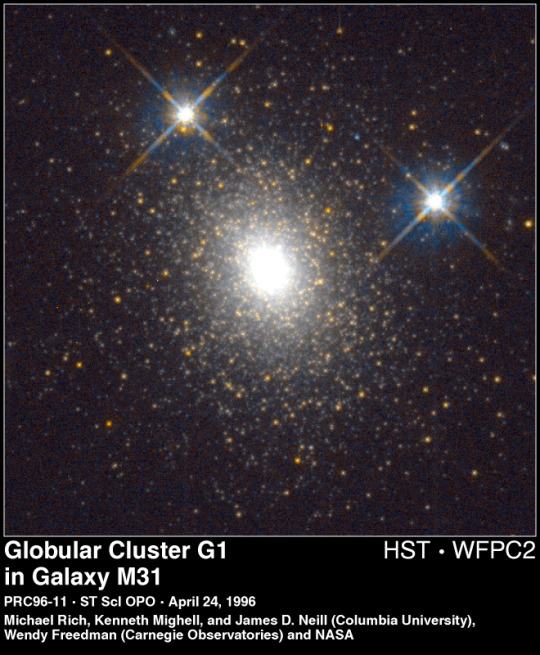
A Giant Globular Cluster in M31 - April 26th, 1996.
"G1, pictured above, is the brightest known globular cluster in the whole Local Group of galaxies. Also called Mayall II, it orbits the center of the largest nearby galaxy: M31. G1 contains over 300,000 stars and is almost as old as the entire Universe. In fact, observations of this globular cluster show stars as old as the oldest of the roughly 250 known globular clusters in our own Milky Way galaxy. This image was taken with the Hubble Space Telescope in July of 1994. It shows, for the first time, the same fine detail in a distant globular cluster as can be discerned from a ground-based telescope of a globular cluster in our own galaxy."
21 notes
·
View notes
Text

In the Center of the Whirlpool - April 25th, 1996.
"In the center of M51, a spiral galaxy 23 million light-years away, astronomers have identified a dense region of young stars. The graceful swirling arcs of this galaxy's spiral arms have inspired its popular name, "The Whirlpool Galaxy". This Hubble Space Telescope image of its nucleus reveals the light from millions of stars, perhaps one tenth the age of the Sun, packed into the bright central region. This area is a mere 80 light-years across - the stars are so crowded here that the view from a hypothetical planet orbiting one of these distant suns would be of a continuously bright sky! The dark "Y" shape visible within this region is an indication that lanes of dust are present, partially blocking the intense starlight."
13 notes
·
View notes
Text
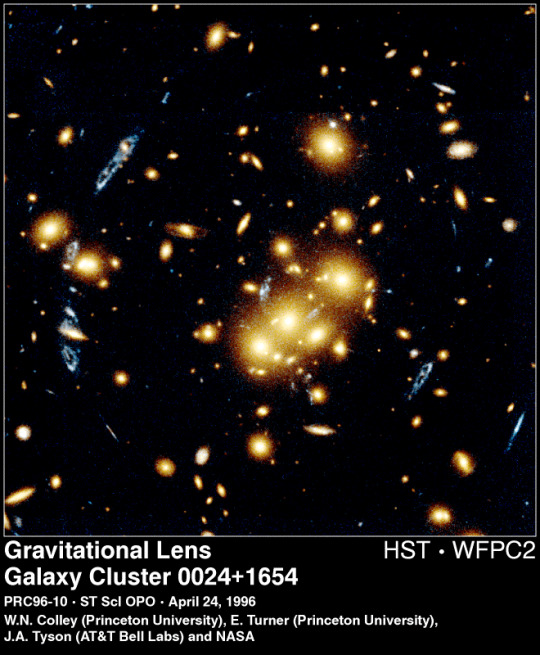
Giant Cluster Bends, Breaks Galaxy Images - April 24th, 1996.
"What are those strange blue objects? Many are images of a single, unusual, beaded, blue, ring-like galaxy which just happens to line-up behind a giant cluster of galaxies. Cluster galaxies here appear yellow and - together with the cluster's dark matter - act as a gravitational lens. A gravitational lens can create several images of background galaxies, analogous to the many points of light one would see while looking through a wine glass at a distant street light. The distinctive shape of this background galaxy - which was probably just forming - has allowed astronomers to deduce that it has separate images at 4, 8, 9 and 10 o'clock, from the center of the cluster. Possibly even the blue smudge just left of the center is yet another image! This spectacular photo from HST was taken in October, 1994. The first cluster lens was found unexpectedly by Roger Lynds (NOAO) and Vahe Petrosian (Stanford) in 1986, while testing a new type of imaging device. Lensed arcs around this cluster, CL0024+1654, were first discovered from the ground by David Koo (UCO Lick) in 1988."
68 notes
·
View notes
Text
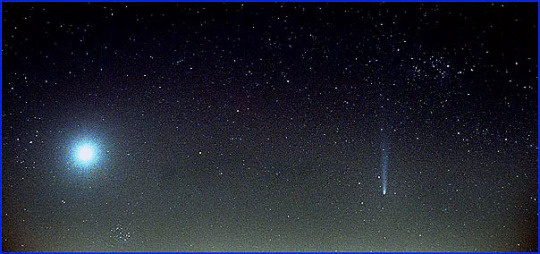
Comet Hyakutake on a Starry Night - April 23rd, 1996.
"It was a starry night in April (April 9th, 1996, 9:32 pm CDT) near Lone Jack, Missouri, when Comet Hyakutake graced this astronomically rich field. Making an appearance as the brilliant evening star, Venus is overexposed at the far left. Just below Venus and slightly to the right, the Pleiades star cluster (M45) glistens. On the right hand side of the image, the comet itself shows a bright blue tail extending upwards past the nearby star cluster in the constellation Perseus (top right, the Alpha Persei Group). Hyakutake, receding from the Earth and appoaching the Sun, would sink into the western horizon at sunset in late April, disappearing from northern hemisphere skies."
#nasa#space#cosmos#universe#astronomy#astrophysics#astrophotography#comet hyakutake#venus#pleiades#perseus constellation
17 notes
·
View notes
Text

At the Edge of the Helix - April 22nd, 1996.
"While exploring the inner edge of the Helix Nebula with the Hubble Space Telescope's Wide Field Planetary Camera 2, astronomers were able to produce this striking image - rich in details of an exotic environment. This planetary nebula, created near the final phase of a Sun-like star's life, is composed of tenuous shells of gas ejected by the hot central star. The atoms of gas, stripped of electrons by ultraviolet radiation from the central star, radiate light at characteristic energies, allowing specific chemical elements to be identified. In this image, emission from nitrogen is represented as red, hydrogen emission as green, and oxygen as blue. The inner edge of the nebula (the direction to the central star) is toward the top left. Clearly visible close to the inner edge are finger shaped "cometary knots"."
30 notes
·
View notes
Text

A Supernova in the Whirlpool - April 21st, 1996.
"In 1994, a new star in a distant galaxy was seen by amateur astronomers, who alerted the world to their discovery of a supernova. Near the nucleus of spiral galaxy M51, popularly known as the Whirlpool, this supernova (1994I) is identified as the bright spot indicated by the arrow in the lower left of this Hubble Space Telescope image. Supernovae are violent death explosions of stars that eject radioactive debri clouds. They are often discovered by amateur observers dedicated to systematic searches of the sky, and are of intense interest to astronomers who hope to learn what kind of stars generate these explosions, and what chemical elements are produced and mixed into space. Distances to these intrinsically bright events can also be determined, providing crucial yardsticks for measuring the scale of the Universe."
#nasa#space#cosmos#universe#astronomy#astrophysics#astrophotography#supernova#whirlpool galaxy#spiral galaxy
20 notes
·
View notes
Text

Apollo 17 Lunarscape: A Magnificent Desolation - April 20th, 1996.
"Buzz Aldrin, Apollo 11 Lunar Module pilot and the second human to walk on the Moon, described the lunar landscape as "a magnificent desolation". Dramatic pictures from the Apollo missions to the Moon's surface testify to this apt turn of phrase. Near the Apollo 17 landing site, Family Mountain (center background) and the edge of South Massif (left) frame the lunarscape in this photo of astronaut Harrison Schmitt working alongside the lunar roving vehicle. Schmitt and fellow astronaut Eugene Cernan were the last to walk on this magnificent desolation."
37 notes
·
View notes
Text
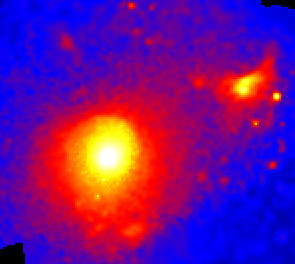
The Virgo Cluster: Hot Plasma and Dark Matter - April 19th, 1996.
"This ROSAT image of the Virgo cluster of galaxies reveals a hot X-ray emitting plasma or gas with a temperature of 10-100 million degrees pervading the cluster. False colours have been used to represent the intensity of X-ray emission. The large area of X-ray emission, just below and left of center, is about 1 million light-years across. The giant elliptical galaxy M87, the biggest member of the cluster, is centered in that area while other cluster members are scattered around it. By adding up the amount of X-ray emitting gas, astronomers have found that its total mass is up to 5 times the total mass of the cluster galaxies themselves - yet all this matter still does not produce nearly enough gravity to keep the cluster from flying apart! Where is the unseen mass? Because galaxy clusters are the largest structures in the Universe, this mysterious dark matter must dominate the cosmos but its nature is still an open question."
21 notes
·
View notes
Text

Hyakutake, Venus, Orion, and Pond - April 18th, 1996.
"Can you find Comet Hyakutake in the above picture? In this gorgeous photo, the starry night sky of April 9th, 1996 is pictured with its new comet visitor. In the foreground is a pond with the lights of Kansas City, Missouri, on the western horizon. On the upper left, the constellation of Orion is visible. At the center, the brightest object in the picture is the planet Venus. Venus' reflection can be seen in the pond. On the right - halfway between Venus and the photograph's edge - can be seen two bright objects fairly close to each other. Of these two, look closely at lower right object. See the tail? Comet Hyakutake was still visible for northern observers in the western sky, and had begun to brighten again as it neared the Sun."
#nasa#space#cosmos#universe#astronomy#astrophysics#astrophotography#comet hyakutake#venus#orion#stars
22 notes
·
View notes
Text

NGC 7293: The Helix Nebula - April 17th, 1996.
"The Helix Nebula (New General Catalog number 7293) is estimated to be a mere 450 light-years from the Sun, in the direction of the constellation Aquarius. At that distance it may well be the closest planetary nebula, offering a dramatic snapshot of a brief final evolutionary stage in the life of a solar-type star. In this colour image, the nebula glows red in the light of nitrogen and hydrogen atoms, energised by the ultraviolet radiation from the central star. The main rings themselves, though faint, have an angular size about half that of the full Moon and span about 1.5 light-years. Because it is so close, it is a prime subject for study by astronomers. When the Hubble Space Telescope was focused near the inner edge of the main ring, at about the 12 o'clock position in the above image, it resolved some of the spoke-like radial structures visible into intriguing cometary knots."
23 notes
·
View notes
Text

Cometary Knots in the Helix Nebula - April 16th, 1996.
"Four hundred fifty light-years from Earth, the wind from a dying, Sun-like star produced a planetary nebula, popularly known as the Helix. While exploring the Helix's gaseous envelope with the Hubble Space Telescope (HST), astronomers discovered indications of 1,000s of striking "cometary knots" like those shown above. So called because of their resemblence to comets, they are actually much larger - their heads are several billion miles across (roughly twice the size of the our Solar System itself) while their tails, pointing radially away from the central star, stretch over 100 billion miles. Previously known from ground-based observations, the sheer number of cometary knots found in this single nebula is astonishing. What caused them to form? Hot, fast moving shells of nebular gas overrunning cooler, denser, slower shells ejected by the star during an earlier expansion may produce these droplet-like condensations, as the two shells intermix and fragment. An intriguing possibility is that instead of dissipating over time, these objects could collapse and form Pluto-like bodies. If so, these icy worlds created near the end of a star's life would be numerous in our galaxy."
38 notes
·
View notes
Text
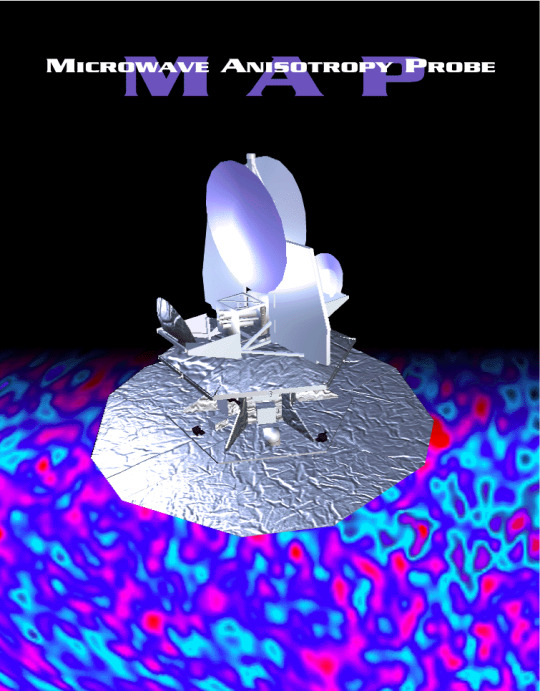
NASA Mission to MAP the Universe - April 15th, 1996.
"What is our Universe made of? How rapidly is our Universe expanding? When did galaxies form? These questions, among the most baffling to astronomers since the beginning of the modern astronomical era, might well be answered by new space satellite missions. The Microwave Anisotropy Probe (MAP) was designed to inspect the Universe's microwave background radiation in more detail then ever before. MAP was to record the frequency, size and temperature of bumps 20 times smaller than COBE. Astronomers had computed what bumps would be expected from several models of our Universe, and comparing these results to MAP's data was predicted to yield a new understanding of the composition and structure of our Universe."
16 notes
·
View notes
Text
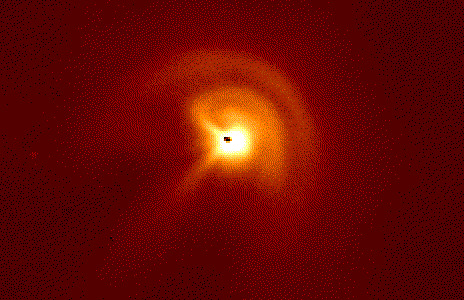
The Rotating Jets of Comet Hyakutake - April 14th, 1996.
"Comet Hyakutake was said to reach its closest point to the Sun on May 1st, 1996, passing well inside the orbit of Mercury. At this time, the comet's dust and ion tail would be at their greatest physical length. As the comet neared the Sun, gas and dust were driven off the surface, sometimes being shot off in jets. Although much of this material ends up in the tail, some interesting features could be seen close to the comet's three kilometer nucleus. Because the comet's nucleus rotates, the jets could be seen to form arcs around the comet's center, resembling a pinwheel. The above photograph, taken on April 8th, 1996, shows two expanding arcs of cometary material and two source jets. The outermost arc is at a projected distance of 12,000 kilometers from the nucleus. The inner is about 8,000 kilometers from the nucleus. They expanded from the nucleus at 870 km per hour. The inner arc ends at the brightest of the Comet Hyakutake's many jets."
29 notes
·
View notes
Text

The Compton Observatory Turns Five - April 13th, 1996.
"Earlier April, 1996, NASA's Compton Gamma Ray Observatory completed its fifth successful year in orbit, exploring the gamma ray sky. Pictured is astronaut Jay Apt perched in the shuttle payload bay below the massive observatory. Compton is the largest civilian instrument ever flown - the whole observatory is roughly the size of a school bus. Apt and colleague Jerry Ross rescued the spacecraft from an unexpected problem by successfully freeing the stuck high gain antenna in an unplanned space walk. The second of NASA's planned Great Observatories for Space Astrophysics, the first being the Hubble Space Telescope, the Compton Gamma Ray Observatory has exceeded expectations of scientific discovery. Compton continues to search the depths of the Universe for such high energy phenomena as gamma-ray bursts, blazars, and pulsars."
15 notes
·
View notes
Text

Man Enters Space - April 12th, 1996.
"Sixty three years ago today, Soviet cosmonaut Yuri Alexseyevich Gagarin became the first human in space. On April 12th, 1961, his remotely controlled Vostok 1 spacecraft lofted him to an altitude of 200 miles, and carried him once around planet Earth. Strictly a passenger, his onboard controls were locked out by a secret combination - in case of an emergency he carried the combination in a sealed envelope. After reentry, Gagarin ejected from the Vostok at an altitude of 20,000 feet and parachuted to Earth. How was the first view from space? He reportedly commented, "The sky is very dark; the Earth is bluish. Everything is seen very clearly". Coupled with other spacefaring accomplishments, this flight seemed to confirm Soviet technological superiority - the first US astronaut would not be launched until almost a month later and then on a comparatively short suborbital flight. Born on March 9th, 1934, Gagarin was an air force jet pilot before being chosen for the first group of cosmonauts in 1960. As a result of his historic flight, he became an international hero and legend. Killed when his MIG jet crashed during a training flight on March 27th, 1968, Gagarin was given a hero's funeral, his ashes interred in the Kremlin Wall."
85 notes
·
View notes
Text
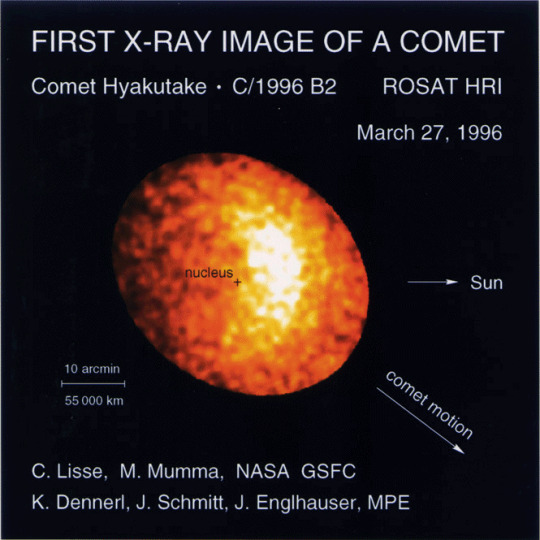
Unexpected X-rays from Comet Hyakutake - April 11th, 1996.
"The first X-rays ever detected from a comet were discovered from Comet Hyakutake with the ROSAT satellite on March 27th, 1996. The discovery was particularly surprising, because there was little previous indication that comets emit any significant X-radiation. As the comet passed the Earth in late March, repeated observations with ROSAT also showed that the X-ray brightness changed over just a few hours. The crescent shape of the X-ray emission is also enigmatic. One possible explanation is that X-rays emitted from the Sun are absorbed by water in the comet's coma, causing fluorescence. Another possible explanation involves interaction with the solar wind - fast moving particles streaming away from the Sun."
35 notes
·
View notes